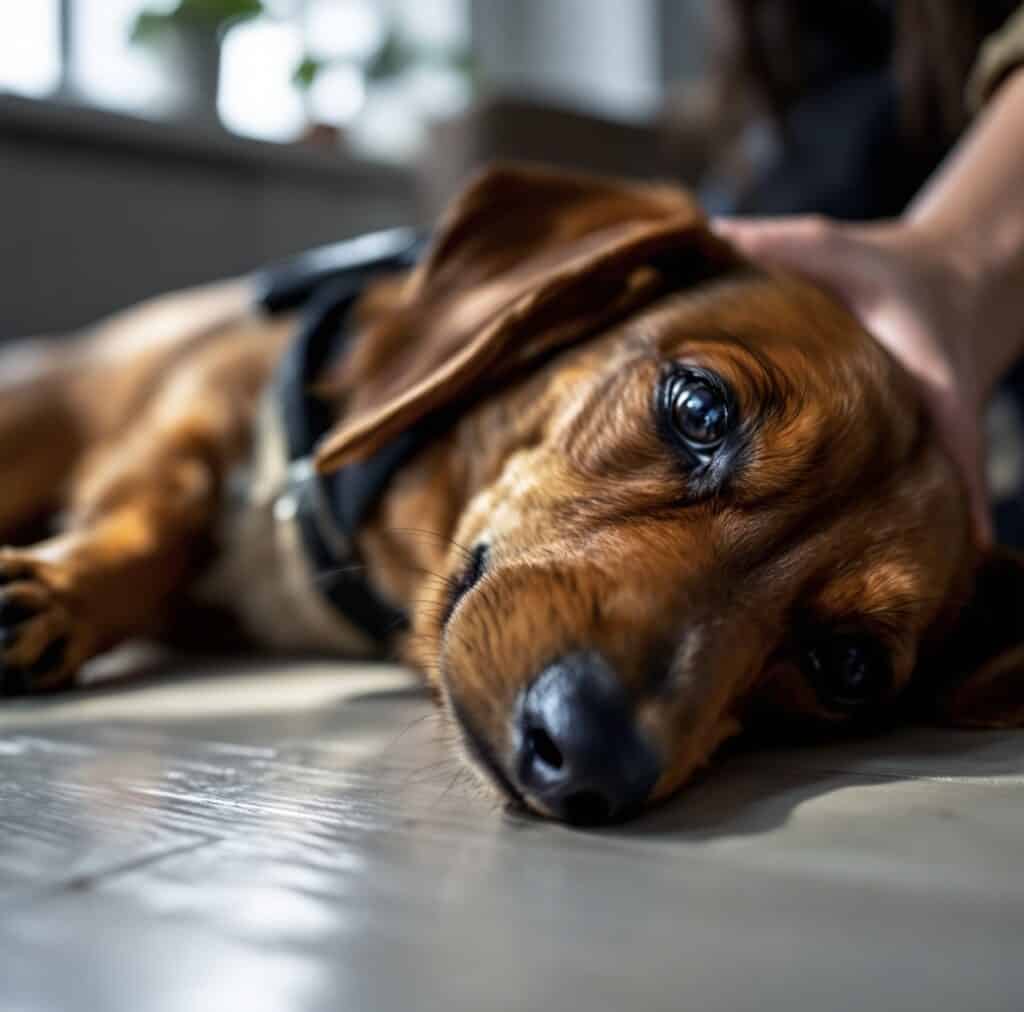No one likes to see their furry friend suffer.
Knowing the 9 signs your Dachshund is in pain and how to help can make a big difference in your dog’s life.
Dachshunds are known to hide their pain, which makes it even more important to recognize subtle signs.
In this post, I’ll walk you through the most common signs of pain and the steps you can take to provide relief for your beloved pup. 🐾

🐕 1. Change in Appetite or Drinking Habits
Why Appetite Changes Matter
When a Dachshund is in pain, it might lose interest in food or water.
This could be a subtle but early sign of discomfort.
How to Monitor Eating and Drinking Patterns
If your dog skips meals or suddenly drinks less water, it’s time to investigate further.
Track changes in their eating habits to share with your vet.
Common Appetite Changes in Painful Dachshunds
| Sign | Potential Cause | Suggested Action |
|---|---|---|
| Refusing food | Pain or gastrointestinal issue | Contact the vet |
| Drinking more water | Inflammation or illness | Schedule a vet visit |
| Eating slowly | Dental pain | Check teeth and gums |
🛏️ 2. Lethargy or Decreased Activity
Why Your Dog Might Slow Down
If your energetic Dachshund suddenly becomes less active, it could indicate pain.
A drop in enthusiasm for walks or playtime is often a red flag.
What to Watch For
Look for signs like avoiding stairs, refusing to jump on furniture, or hiding under the bed.
Dachshunds often conserve energy to cope with pain.
Signs of Reduced Activity
| Behavior | Potential Issue | Recommended Action |
|---|---|---|
| Avoiding stairs | Back pain or injury | Consult a vet |
| Sleeping excessively | Chronic pain | Monitor sleep patterns |
| Reluctant to play | Joint or muscle pain | Limit activity, see vet |
🐾 3. Limping or Favoring a Limb
Identifying Mobility Issues
A sudden limp or refusal to put weight on a paw is often a sign of pain.
This could result from an injury or an underlying joint problem.
When to Seek Help
If the limp persists for more than 24 hours, schedule a vet visit immediately.
Keep your dog from running or jumping to prevent further injury.
Causes of Limping
| Cause | How It Affects Dachshunds | What to Do |
|---|---|---|
| Muscle strain | Temporary limp | Rest for a few days |
| Joint inflammation | Persistent discomfort | Anti-inflammatory meds |
| Paw injury | Visible cuts or swelling | Clean wound, visit vet |
🛋️ 4. Reluctance to Jump or Climb
Why This Behavior Matters
Dachshunds love to jump on couches or climb stairs.
When they avoid these activities, it often points to back or joint pain.
How to Prevent Injuries
Place ramps or steps to help your dog get onto furniture safely.
If your Dachshund shows pain signs while climbing, limit their movement and visit a vet.
Common Reasons for Reluctance to Jump
| Reason | Impact on Mobility | Solution |
|---|---|---|
| Back pain | Avoids climbing or jumping | Use ramps, rest dog |
| Arthritis | Joint stiffness | Consult a vet for meds |
| Muscle injury | Temporary immobility | Rest and monitor closely |
😢 5. Whimpering or Yelping Without Obvious Reason
Vocal Signs of Pain
Dogs may vocalize when they’re in pain, even without an apparent cause.
Whimpering, yelping, or whining might indicate discomfort.
When to Be Concerned
Take note if your dog becomes more vocal, especially when touched or picked up.
Persistent whining could mean your Dachshund needs immediate medical attention.
Common Vocal Signs of Pain
| Sound | Possible Cause | Action |
|---|---|---|
| Whimpering | General pain | Monitor for other signs |
| Yelping when touched | Back or abdominal pain | Visit the vet promptly |
| Excessive whining | Chronic pain | Vet check recommended |
🧸 6. Changes in Sleep Patterns
Why Sleep is Important
A sudden change in sleep patterns could indicate your dog is experiencing pain.
Sleeping more than usual or having trouble sleeping is often linked to discomfort.
How to Monitor Sleep Changes
Track how often your Dachshund sleeps and whether it wakes up in the middle of the night.
Frequent interruptions in sleep could suggest hidden pain.
Sleep Pattern Changes and Causes
| Sleep Change | Possible Cause | Suggested Action |
|---|---|---|
| Sleeping more | Chronic pain or illness | Monitor and consult vet |
| Trouble falling asleep | Pain or anxiety | Provide a calming space |
| Waking up frequently | Discomfort or stress | Investigate further |
🦴 7. Excessive Licking or Chewing
What Excessive Grooming Could Mean
If your Dachshund constantly licks or chews a specific area, it might be trying to soothe pain.
This behavior is often linked to skin conditions, joint pain, or injuries.
How to Address the Issue
Inspect the area for redness, swelling, or wounds.
Contact your vet if the behavior persists to rule out underlying health issues.
Areas Commonly Licked
| Area Licked | Possible Issue | Recommended Action |
|---|---|---|
| Paws | Allergies or injury | Inspect and treat |
| Belly | Skin irritation | Apply soothing ointment |
| Joints | Pain or arthritis | Consult a vet |
🛌 8. Hiding or Avoiding Interaction
Why Isolation Can Signal Pain
If your social Dachshund starts hiding or avoiding you, it might be experiencing discomfort.
Pain often causes dogs to seek solitude to cope.
What to Watch For
Look for changes in behavior, such as hiding under furniture or avoiding petting.
Sudden withdrawal is a red flag and requires attention.
Hiding Behaviors and Possible Causes
| Behavior | Potential Cause | Suggested Action |
|---|---|---|
| Hiding under bed | Back pain | Visit the vet |
| Avoiding interaction | Discomfort or illness | Monitor closely |
| Withdrawn behavior | Chronic pain | Seek veterinary help |
🩺 9. Changes in Breathing Patterns
Why Breathing Changes Matter
Panting or labored breathing in Dachshunds can indicate stress, pain, or illness.
This is especially concerning if it happens without exercise or heat exposure.
How to Monitor Breathing Changes
Watch for signs like rapid panting or shortness of breath.
Contact your vet immediately if breathing changes are accompanied by other symptoms.
Breathing Changes and What They Indicate
| Breathing Change | Possible Cause | Recommended Action |
|---|---|---|
| Rapid panting | Pain or stress | Provide a calm space |
| Shallow breathing | Internal injury | Seek emergency care |
| Heavy breathing | Discomfort or fever | Visit the vet promptly |
🏁 Conclusion: 9 Signs Your Dachshund Is in Pain and How to Help
Recognizing these 9 signs your Dachshund is in pain and how to help will ensure your pet gets the care it needs.
Early intervention makes a significant difference in your dog’s recovery and well-being.
If you notice any of these signs, consult your vet immediately for proper treatment.
Your quick action can bring comfort and happiness back to your beloved Dachshund.
🧐 Frequently Asked Questions
1. How do I know if my Dachshund is in pain?
Look for signs such as changes in behavior, appetite, and sleep patterns, as well as limping or vocalizations.
2. Why is my Dachshund hiding and avoiding me?
Hiding or avoiding interaction can indicate pain or discomfort. It’s essential to observe other signs and consult your vet.
3. Can Dachshunds develop arthritis?
Yes, Dachshunds are prone to joint issues like arthritis, especially as they age. Regular vet check-ups can help manage symptoms.
4. What should I do if my Dachshund refuses to eat?
A loss of appetite could signal pain or illness. If it persists for more than 24 hours, schedule a vet visit.
5. Why is my Dachshund yelping when I pick it up?
Yelping when touched could indicate back pain or abdominal discomfort. Visit your vet immediately if this occurs.
6. How can I comfort my Dachshund if it’s in pain?
Provide a calm environment, limit physical activity, and consult your vet for pain management options.
7. Should I give my Dachshund over-the-counter pain medications?
Never give human medications to your dog without consulting a vet. Some medications can be toxic to dogs.
8. How often should I check my Dachshund for signs of pain?
It’s a good idea to monitor your Dachshund’s behavior daily, especially if it has a history of health issues.
9. Can excessive licking indicate pain?
Yes, excessive licking of a specific area may indicate discomfort or injury. Check the area and contact your vet if needed.
10. When should I take my Dachshund to the vet?
If you notice multiple signs of pain or any sudden behavioral changes, it’s best to consult your vet as soon as possible.
For more insights, explore:
